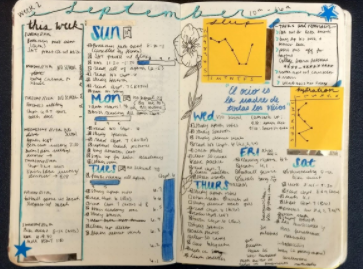While some high schoolers may opt for digital calendars or store-bought agendas to keep track of assignments and events, an emerging self-made option is the bullet journaling system, which gets its name from the faintly printed grid of dots on each page of the journal. The journaler can easily use the dots as a guideline for checklists, calendars, and even artwork.
“A bullet journal is basically this blank journal that you can use and really, the great thing about it is how flexible it can be. It can be an agenda for some people, and other people use it kinda like an agenda, journal [or] diary kind of thing, and it’s just a way for you to compile all your memories together and see it chronologically,” said junior Alyssa Wu, who switched to the bullet journaling system from a store-bought agenda in the second semester of her sophomore year.
“In freshman year, I got this agenda that covered all of freshman year and half of sophomore year, so then we got to the second semester of sophomore year, I was like ‘I don’t have a way to keep track of stuff anymore,’” said Wu. “ I didn’t want to buy another agenda, because I’d only be able to use half of it, so I was like, ‘Let’s just begin bullet journaling.’”
Junior Sarah Mackey decided to try bullet journaling in her freshman year and has maintained a bullet journal since then.
“After they [the school] stopped giving you an agenda every year after middle school, I needed something to use, and I’d seen bullet journals online and thought that it might be a interesting thing to start doing, so I started the summer before freshman year,” said Mackey.
There are various possibilities for how to structure “spreads”, which are pages assigned to a specific month, week, or day.
“I do it weekly, with an overview [of my week] on the side and a month overview at the top, and then I have how much sleep and water I drink, if I run, if I read my textbook stuff, notes, reminders, and songs that I like,” said Mackey.
Mackey’s water and sleep trackers are often called “habit trackers” in the bullet journal community, but they are certainly not for everyone.
“I tried to [use habit trackers], but it was just too much work, so I gave up,” said junior Diana Haiden, who also bullet journals.
Wu opted for a different style of layout from Mackey.
“I plan it by the week, but I don’t have Monday, Tuesday, Wednesday, I kinda do it by subjects,” said Wu.
Creatively, bullet journaling has a broad range of possibilities. For instance, Mackey wrote all of her spreads for the month of July in German, because she was traveling abroad in Germany during that time. Junior Emi McCollum enjoys working bright colors into her spreads.
“For August, I did all red, but usually I don’t have a scheme. Usually it’s whatever color I want. Sometimes I try to match it with the season,” said McCollum.
There are several brands that many bullet journalers trust, such as Stabilo pens and Leuchtturm journals. McCollum, however, has other brands she recommends.
“I think I paid $6 for some [Tombow brush] pens,” said McCollum.
She also uses a Moleskine notebook, which has a soft and bendable cover unlike the Leuchtturm journals that Wu, Mackey, and Haiden all use.
The financial costs of these supplies may come as surprise to some. Because name brands such as Stabilos are dependable yet costly, there are other brands that can be very affordable.
“It’s actually cheaper than getting an agenda planner,” said Haiden. Mackey also confirmed the affordability of bullet journaling.
“The notebook I use is $20 and then I have various pens,”said Mackey, who also uses the pens for tasks other than updating her bullet journal.
As for the amount of time needed to maintain a bullet journal, it can be very easy to update the journal because of its portability.
“I do it throughout the day, so as I get assignments, I’ll write them in or I’ll write them in at the end of the day,” said Mackey.
For some, however, tediously updating a bullet journal proved to be more trouble than it was worth.
“I tried [bullet journaling] because I needed a form of a planner, and I wanted to try to make it myself, but I just found that I was spending more time making it and organizing it than I was actually using it to plan my life,” said junior Stella Demer, who no longer keeps a bullet journal.
However, the process of keeping a bullet journal can be rewarding and beginners can find ideas for spreads from a variety of resources.
“I just basically found stuff [like spread ideas] on Pinterest or online,” said Haiden.
Wu also encourages beginners to experiment with their layouts and design, but understands that making the pages pretty can be difficult for those not artistically talented.
“Make it what helps you most,” said Wu. “If you’re really into art and design, then it’s a great way to show some of your creativity, but if you just need an agenda substitute, like I do, there’s really no reason to put that much effort, just for it to look nice.”
As for making your bullet journal into something you enjoy using, Mackey believes that originality is key.
“I think that it’s important to not just try to copy other people and instead to figure out what works for you, because at the end of the day, you have to have a functional notebook in order for it to be effective,” said Mackey.








